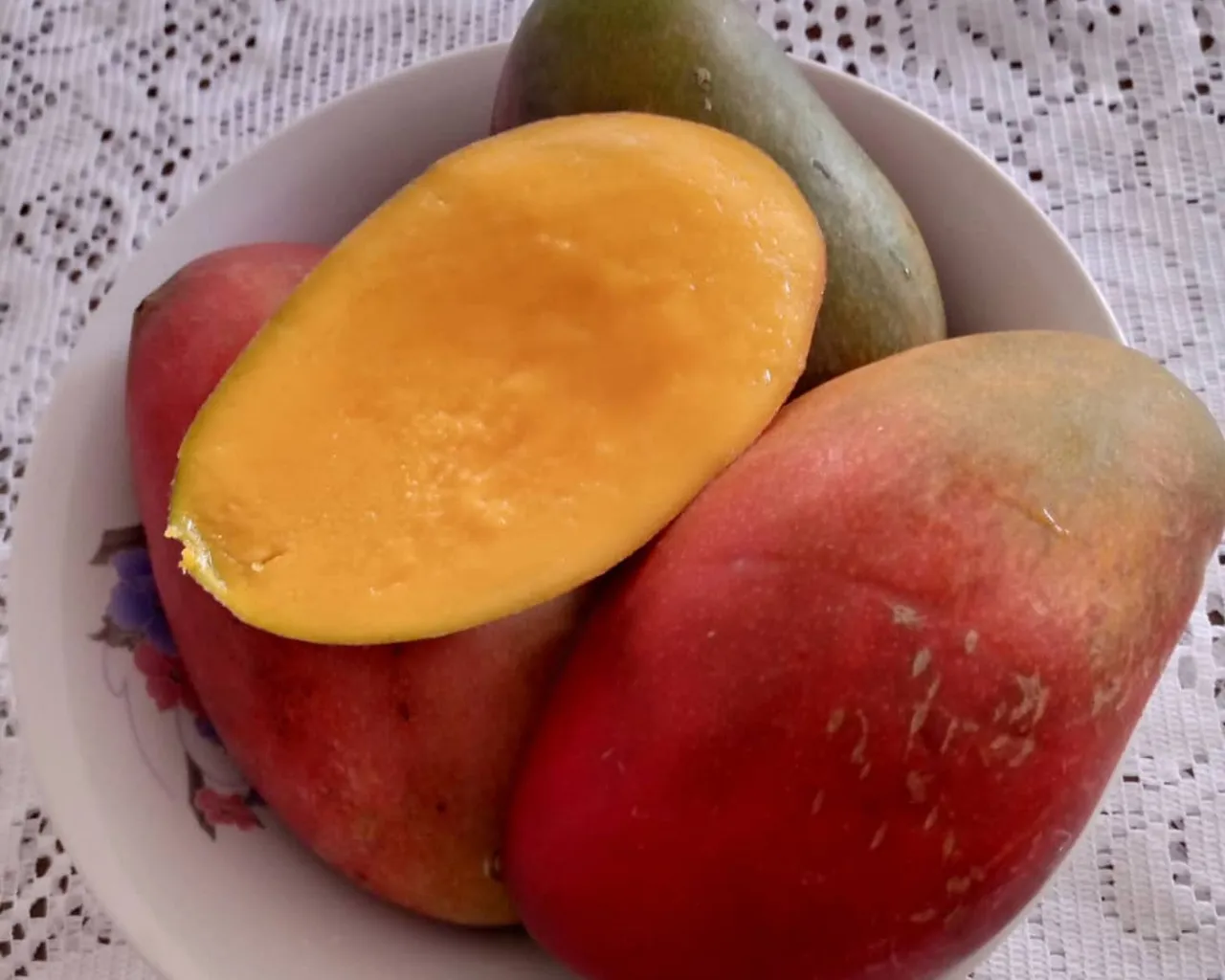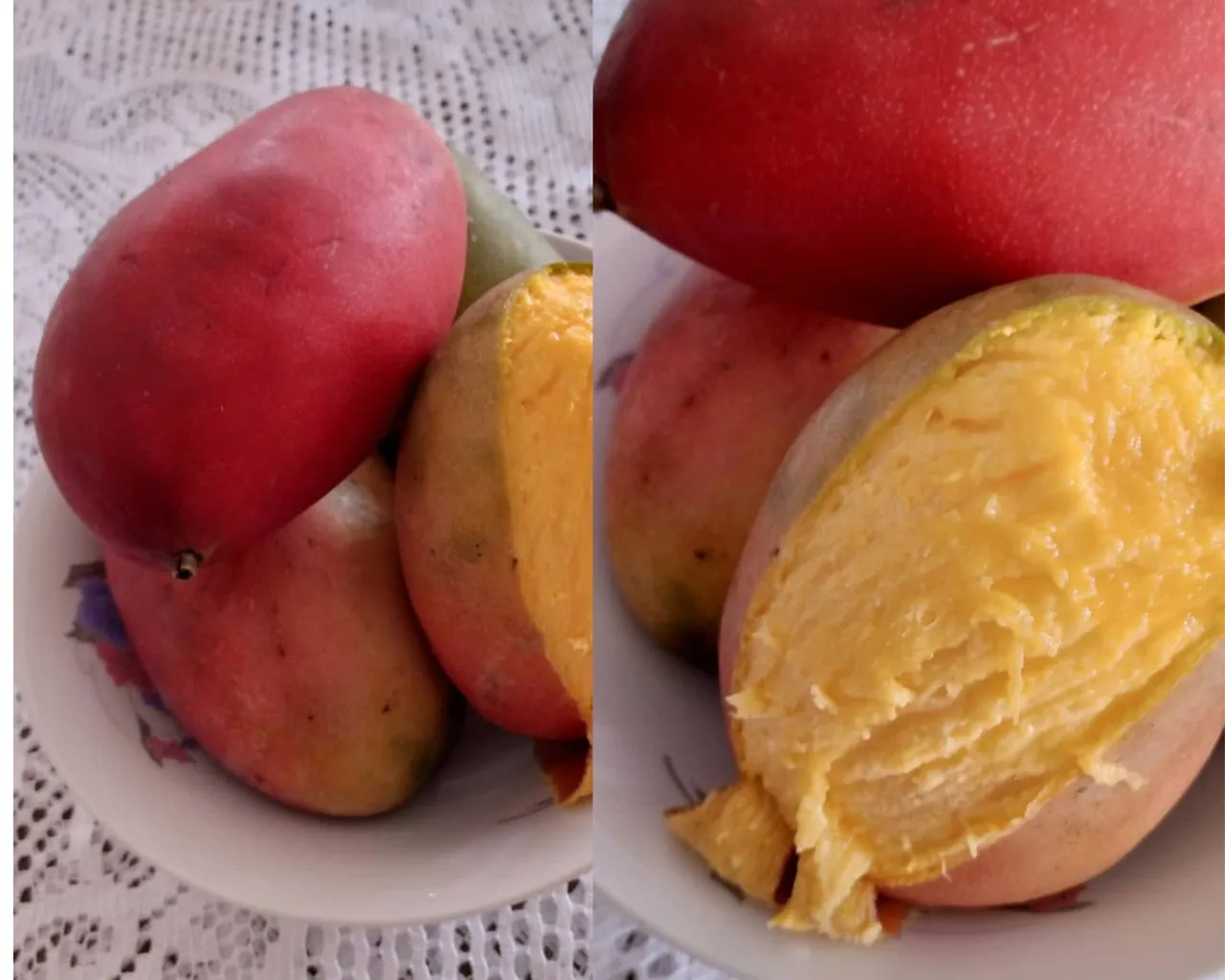Llegó la temporada de mango! En realidad inició a finales de Abril y tendremos mango para rato pues la temporada de cosecha termina en Septiembre!

Quien ha probado un mango, sabe lo delicioso que es, cada bocado es una explosión de jugo, quedando nuestra boca impregnada de ese sabor dulzón y ese aroma que agrada a los sentidos.
Hay muchos tipos de mango, los hay con concha gruesa, pero otras veces la concha es tan delgada que se puede comer. Los hay de hilacha (no me gustan), de bocado y mis favoritos mango injerto y manga. Por estos dos me doy pelea y mi mascota también. Su forma es ovalada y en algunos casos alargada, su semilla es alargada y delgada.
El caso es que como vengan son deliciosos: en jugo, en postre, jaleas, merengadas, en ensaladas y mi forma favorita, comiendo directamente la fruta. Muchas personas consumen el mango verde con sal y adobo! La he probado, pero no es mi favorita.

¿Cuál es la razón de este post?
Muy sencillo, por motivos de salud he tenido que cambiar mis hábitos alimenticios, así es, antes acostumbrada a comer harinas procesadas y en este momento mi cuerpo no las tolera, por lo que he tenido que buscar otras formas de alimentación.
Y que mejor forma de alimentarme que voltear a ver a la naturaleza, reconciliarme con los vegetales, con las verduras, hortalizas y sobre todo con las frutas, que antes de broma las consumía en jugo.
El consumo del mango me ha ayudado a tolerar el tratamiento de antibióticos, que por demás está decir, me dejan un sabor amargo y desagradable en mi boca, además de afectar a mi estómago.
Pero cada vez que tomo una pastilla, tras ella consumo una fruta y por lo general es el mango, que definitivamente es el que, para mi gusto, tiene el sabor más dulce. Luego de consumir la fruta, el malestar de estómago y el amargo de la boca se desaparecen.
El mango me ha ayudado a tolerar un tratamiento que a muchas personas les afecta y tal como me dijo el doctor, me iba a sentir mal y hasta podría desear abandonarlo, pero gracias al cambio en mi alimentación y definitivamente al consumo del mando durante el tratamiento, ha sido una experiencia no tan traumática.

Distribución y Cosecha
Cosa que no sabía, pero el mango es de origen asiático, específicamente en la India, Birmania y las Islas Adaman, posteriormente fue introducido en América Latina (en la zona tropical, donde se dan los mejores frutos).
Así que el mango se da en Colombia, Perú, Brasil, Paraguay, al Norte de Argentina y por supuesto Venezuela. Así que por estas fechas no es extraño conseguirnos tan magnifico fruto en los supermercados y tiendas de vegetales y frutas.
Cuando hay cosecha de mango, es usual ver los arboles cargados y con sus frutas casi cayendo al piso. Cuando su concha está roja o amarilla, están listos de cosechar, lo que se hace de la forma tradicional: a mano. Muchas veces en zonas despobladas podemos ver una alfombra amarilla – rojiza bajo los árboles, dándole así sustento a los animales de la zona.
En los países ubicados en el trópico y a una altura inferior a los 1.200 metros sobre el nivel del mar, esta aromática fruta se da durante todo el año, pero con una mayor producción entre los meses de abril a Septiembre, así que somos privilegiados, podemos consumir mango por unos 6 meses. La otra mitad del año, los encontraremos pero su precio será más elevado.

Qué nos aporta comer mango
Luego de cambiar mis hábitos alimenticios también me he dado a la tarea de averiguar por el aporte nutricional de cada vegetal, hortaliza, verdura o fruta que consumo. Además de preferir los alimentos que requiera poca cocción a fin de aprovechar al máximo sus nutrientes.
Así que he descubierto que el mango aporta una gran variedad de vitaminas, minerales, fibra y antioxidantes, tan necesarias para el saludable crecimiento de nuestras células. Así que vamos a hablar un poco de los beneficios de consumir mango regularmente.
Vitaminas y Minerales
- Rico en antioxidantes.
- Contiene fibra, ideal para nuestra digestión.
- Contiene aminoácidos que combinados con las proteínas, son el pilar fundamental de nuestra subsistencia.
- Aportan a nuestro organismo vitamina A, B1, B2, B3, B5, B6, C, E, K y ácido fólico.
- Minerales: contiene calcio, flavonoides, beta-caroteno, niacina, potasio, fósforo, hierro, magnesio, manganeso, sodio y zinc.
En mi investigación descubrí que 200 gramos de esta fruta aportan 23 gramos de vitamina E, 60 gramos de vitamina C, 35 gramos de vitamina A y proporciona el 10 % de la dosis recomendada de magnesio y potasio.
En conclusión el mango tiene una excelente mezcla de vitaminas, minerales y otras propiedades, además de ser una fruta adictiva. Si te comes una, vas a querer más.

Beneficios para la salud
Ahora vamos a ver qué beneficios tiene para nuestra salud comer mango, partiendo de los aportes nutricionales anteriores:
- Ayuda a aumentar el peso corporal. Ideal para mí, que estoy por debajo del límite de peso de acuerdo a mi estatura. Cada 100 gramos de mango contiene 75 calorías! Que vivan las calorías!
- Mejora la Digestión. Al tener fibra, ayuda al tránsito intestinal, evita el estreñimiento y sus antioxidantes ayudan a eliminar las toxinas.
- Ayuda a controlar la acidez estomacal, debido a sus enzimas.
- Cuida nuestros ojos: Al contener vitamina A, ayuda a la prevención de enfermedades en nuestros ojos. “Comerlo regularmente previene la ceguera nocturna, los errores de refracción, el ojo seco, el ablandamiento de la córnea, la picazón y ardor en los ojos. Además, el consumo regular de mango, reduce el riesgo de sufrir de degeneración muscular por ciptoxantina.” RG.com
- Aportan beneficios a la piel. Su aporte de vitamina A y betacaroteno protege la mucosa y piel de los radicales libres, haciendo ver la piel más tersa, suave y con menos envejecimiento.
- Reduce el colesterol dañino.
- Fortalece el sistema inmunológico.
- Gracias a la vitamina K, permite una mejor absorción del calcio, fortaleciendo los huesos.
- Los mangos contienen fenoles, quercetina, isoquercitrin, astragalin, fisetina, ácido gálico y pectima, que tienen propiedades para combatir el cáncer.
- Ideal para personas con anemia, pues la vitamina C del mango ayuda en la absorción del hierro.
Así que mi amigo lector, que esperas para tener tu ración diaria de mango en tu menú diario! Luego de leer todos los beneficios, no dudé ni un momento y decidí que mi ración diaria superaría los 200 gramos!, o dicho de otra manera un mango mediano.
Si llegaste hasta aquí, gracias por leerme!
Referencias:
Wikipedia
Actualidad-24.com
RG Frutas Tropicales

NOW IN ENGLISH
Mango season is here! Actually it started at the end of April and we will have mangoes for a while because the harvest season ends in September!

Whoever has tasted a mango, knows how delicious it is, each bite is an explosion of juice, leaving our mouth impregnated with that sweet taste and aroma that pleases the senses.
There are many types of mangoes, some have a thick shell, but other times the shell is so thin that you can eat it. There are hilacha (I don't like them), bocado and my favorite mangoes, mango graft and mango manga. I fight for these two and so does my pet. Their shape is oval and in some cases elongated, their seed is elongated and thin.
The fact is that they are delicious as they come: in juice, in desserts, jellies, meringues, in salads and my favorite way, eating the fruit directly. Many people eat the green mango with salt and marinade! I have tried it, but it is not my favorite.

What is the reason for this post?
Very simple, for health reasons I have had to change my eating habits, that's right, before I was used to eating processed flours and now my body does not tolerate them, so I had to look for other ways of eating.
And what better way to feed myself than to turn to nature, to reconcile myself with vegetables, with greens, vegetables and especially with fruits, which before I used to consume them in juice as a joke.
The consumption of mango has helped me to tolerate the treatment of antibiotics, which, needless to say, leave a bitter and unpleasant taste in my mouth, besides affecting my stomach.
But every time I take a pill, after it I consume a fruit and it is usually mango, which is definitely the one that, to my taste, has the sweetest flavor. After consuming the fruit, the upset stomach and bitterness in my mouth goes away.
The mango has helped me tolerate a treatment that many people are affected by and as the doctor told me, I was going to feel bad and I might even want to give it up, but thanks to the change in my diet and definitely the consumption of the mango during the treatment, it has been a not so traumatic experience.

Distribution and Harvesting
What I didn't know, but the mango is of Asian origin, specifically in India, Burma and the Adaman Islands, later it was introduced in Latin America (in the tropical zone, where the best fruits are grown).
So mangoes are found in Colombia, Peru, Brazil, Paraguay, northern Argentina and of course Venezuela. So at this time it is not strange to find this magnificent fruit in supermarkets and vegetable and fruit stores.
When there is mango harvest, it is usual to see the trees loaded and with their fruits almost falling to the ground. When their shells are red or yellow, they are ready to be harvested, which is done in the traditional way: by hand. Many times in unpopulated areas we can see a yellow-reddish carpet under the trees, giving sustenance to the animals of the area.
In countries located in the tropics and at an altitude below 1,200 meters above sea level, this aromatic fruit occurs throughout the year, but with a higher production between the months of April to September, so we are privileged, we can consume mango for about 6 months. The other half of the year, we will find them but their price will be higher.

What's in it for us to eat mangoes
After changing my eating habits, I have also taken on the task of finding out about the nutritional contribution of each vegetable, vegetable, vegetable or fruit that I eat. In addition to preferring foods that require little cooking in order to make the most of their nutrients.
So I have discovered that mangoes provide a great variety of vitamins, minerals, fiber and antioxidants, so necessary for the healthy growth of our cells. So let's talk a little bit about the benefits of consuming mangoes on a regular basis.
Vitamins and Minerals
- Rich in antioxidants.
- Contains fiber, ideal for our digestion.
- Contains amino acids that combined with proteins, are the fundamental pillar of our subsistence.
- They provide our organism with vitamin A, B1, B2, B3, B5, B6, C, E, K and folic acid.
- Minerals: it contains calcium, flavonoids, beta-carotene, niacin, potassium, phosphorus, iron, magnesium, manganese, sodium and zinc.
In my research I found that 200 grams of this fruit provides 23 grams of vitamin E, 60 grams of vitamin C, 35 grams of vitamin A and provides 10% of the recommended dose of magnesium and potassium.
In conclusion, mango has an excellent mix of vitamins, minerals and other properties, besides being an addictive fruit. If you eat one, you will want more.

Health benefits
Now let's see what benefits eating mangoes has for our health, starting from the previous nutritional contributions:
- It helps to increase body weight. Ideal for me, I am below the weight limit according to my height. Each 100 grams of mango contains 75 calories! Long live calories!
- Improves Digestion. Because it has fiber, it aids intestinal transit, prevents constipation and its antioxidants help eliminate toxins.
- It helps control stomach acidity, due to its enzymes.
- It takes care of our eyes: Containing vitamin A, it helps prevent eye diseases. "Eating it regularly prevents night blindness, refractive errors, dry eye, corneal softening, itching and burning eyes. In addition, regular consumption of mango reduces the risk of suffering from cytoxanthin muscle degeneration." RG.com
- They bring benefits to the skin. Its contribution of vitamin A and beta-carotene protects the mucosa and skin from free radicals, making the skin look smoother, softer and with less aging.
- Reduces harmful cholesterol.
- Strengthens the immune system.
- Thanks to vitamin K, it allows a better absorption of calcium, strengthening bones.
- Mangoes contain phenols, quercetin, isoquercitrin, astragalin, fisetin, gallic acid and pectic acid, which have cancer-fighting properties.
- Ideal for people with anemia, because the vitamin C in mangoes helps in the absorption of iron.
So my reader friend, what are you waiting for to have your daily ration of mango in your daily menu! After reading all the benefits, I did not hesitate for a moment and decided that my daily ration would exceed 200 grams, or in other words a medium mango.
If you made it this far, thanks for reading me!
References:
Wikipedia
Actualidad-24.com
RG Frutas Tropicales

